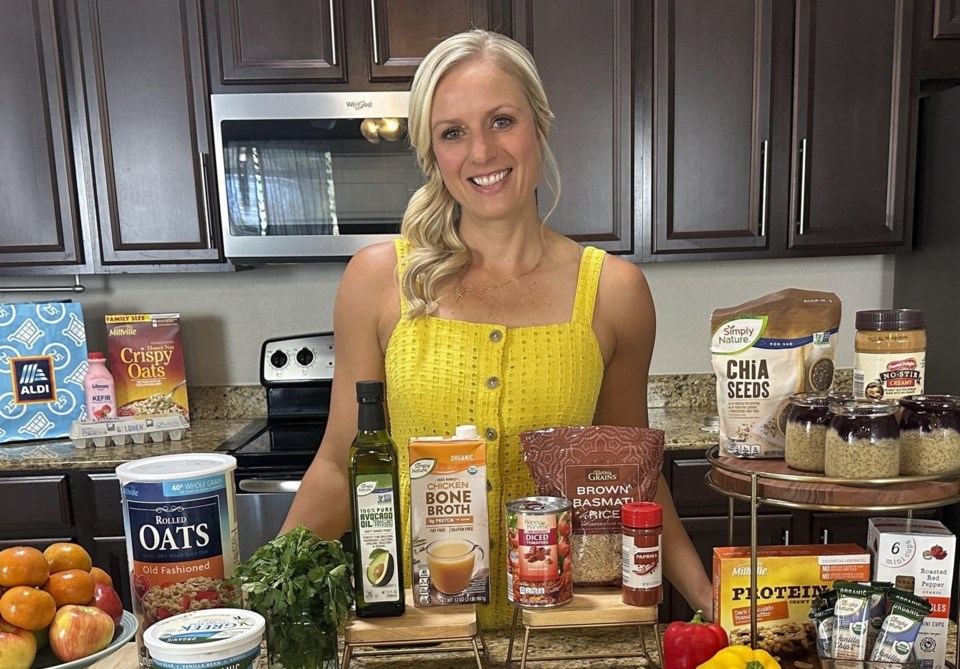When Jennifer Anastasiou decided to go vegetarian after learning about the environmental impact of livestock, she worried at first about her protein intake.
“It was kind of hard because when you eat meat your entire life, you don’t even have to think that way,” said Anastasiou, who grew up eating plenty of meat in her Irish-Catholic family in Philadelphia.
Now, she relies heavily on foods that dietitians recommend for those cutting down on meat: high-protein legumes like lentils, chickpeas and beans, vegetable-based protein shakes and other sources.
Many people consider eating less meat, be it for health, environmental or animal-welfare reasons. (Livestock accounts for nearly half of agricultural emissions fueling climate change.) But they sometimes hesitate because they are concerned about how they would replace all that lost protein.
The USDA has a calculator to determine daily nutrient recommendations, but those values represent the minimum amount you need to maintain healthy functioning, said Jenna Braddock, a dietitian in St. Augustine, Florida. She said research suggests 1.2 to 2 grams per kilogram of weight, depending on your goals.
A good way to reach your goal is what she called protein stacking: adding a small amount of nuts, whole-grain bread or legumes to meals you already are eating.
“It’s going to be hard to get all of that protein from one single plant-based source, whether because of either the quantity of food that you’d have to eat or the calories that it would end up being,” said Braddock, co-author of “The High-Protein Vegan Cookbook for Athletes.”
She recommended making a batch of lentils on the weekend — half a cup has 9 grams — to stuff into tacos, add to salads or just eat on their own. Frozen edamame are an easy go-to, and tempeh, an Indonesian fermented soy product, has 18 grams “in a pretty manageable serving size,” Braddock said.
Hemp hearts have a chewy texture, high fiber and about 3 grams of protein per tablespoon. One of her favorite snacks is yogurt with hemp hearts, fresh fruit and a drizzle of peanut butter.
Peanuts get forgotten when people talk about healthy nuts, Braddock said, but she highlights them because they’re more affordable and still have 8 grams of protein per 1/4 cup. Seeds like pumpkin, sunflower and chia also generally are cheap and high in protein. As is quinoa, which seems like a grain but is actually a seed.
For people who might not like the texture of beans or tofu, Braddock recommended blending them into a creamy soup or making dips out of them. Or ask around to find the restaurant that makes the best version of tofu, for example, so you start with a positive experience you’ll be more likely to repeat at home.
“Make your entry point as delicious and as easy as possible,” she said. “When it comes to eating more vegetarian or vegan, it’s not just a switch you turn on. It’s a journey you take that you will grow in skills, ability, knowledge and competency in the kitchen.”
Try these two recipes from “ The High-Protein Vegan Cookbook for Athletes,” by Jenna Braddock and Ivy Stark.
TOASTED PUMPKIN SEED DIP
Serves 4
Time: 30 minutes
Ingredients
1 cup hulled pepitas (pumpkin seeds)
3 plum tomatoes
1 small red onion, finely chopped
4 cloves garlic, roasted
¼ cup finely chopped cilantro
1/2 habanero chile, stemmed, seeded and finely chopped (optional)
1 tablespoon chipotle chile en adobo, finely minced
Juice of 1 lime
Juice of 1/2 orange
1 teaspoon ground cinnamon
Directions
Place the pepitas in a large skillet over medium-low heat. When the first one pops, stir constantly until all have popped from flat to round, about 5 minutes. Blend in a food processor to a smooth paste, scraping down the sides a few times.
Place the tomatoes on a baking sheet under the broiler and roast until blackened and very soft, flipping halfway through, about 6 minutes per side. Cool and finely chop.
In a medium bowl, combine the seed paste, tomatoes, onion, garlic, cilantro, chipotle and habanero. Stir in lime juice, orange juice and cinnamon. Taste and season with sea salt.
Serve with warm corn tortillas or crisp vegetables like baby carrots, cucumber slices, radishes and sliced fennel.
—
QUINOA PILAF WITH ASPARAGUS
Serves: 4
Time: 40 minutes
Ingredients
2 cups red quinoa
4 1/2 cups water
1/2 teaspoon salt
1 bunch thin asparagus, roughly chopped
2 tablespoons extra-virgin olive oil
1 teaspoon ground cumin
Juice and zest of 1 lemon
1/2 cup pine nuts, lightly toasted
1 small red onion, finely chopped
1/2 small bunch fresh basil, chopped
2 sprigs fresh thyme, chopped
Directions
Place the quinoa in a large strainer. Rinse under cold running water until the water runs clear. Transfer quinoa to large saucepan; add the water and salt. Bring to boil.
Reduce heat to medium-low, cover and simmer until water is absorbed and quinoa is tender, about 20 minutes. Transfer quinoa to large bowl, add asparagus and let sit covered for 5 minutes, fluff with fork. Stir in oil cumin, and lemon juice and zest. Season with salt and pepper.
Add pine nuts, red onion, basil, and thyme to the warm quinoa just before serving.
The quinoa will hold well covered in the fridge for five days, just add the garnishes when you are ready to reheat and serve.
EDITOR’S NOTE: Albert Stumm writes about food, travel and wellness. Find his work at https://www.albertstumm.com
Albert Stumm, The Associated Press




